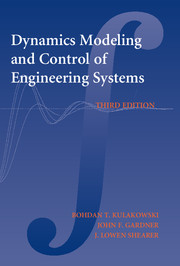Book contents
- Frontmatter
- Contents
- Preface
- Dynamic Modeling and Control of Engineering Systems
- 1 INTRODUCTION
- 2 MECHANICAL SYSTEMS
- 3 MATHEMATICAL MODELS
- 4 ANALYTICAL SOLUTIONS OF SYSTEM INPUT–OUTPUT EQUATIONS
- 5 NUMERICAL SOLUTIONS OF ORDINARY DIFFERENTIAL EQUATIONS
- 6 SIMULATION OF DYNAMIC SYSTEMS
- 7 ELECTRICAL SYSTEMS
- 8 THERMAL SYSTEMS
- 9 FLUID SYSTEMS
- 10 MIXED SYSTEMS
- 11 SYSTEM TRANSFER FUNCTIONS
- 12 FREQUENCY ANALYSIS
- 13 CLOSED-LOOP SYSTEMS AND SYSTEM STABILITY
- 14 CONTROL SYSTEMS
- 15 ANALYSIS OF DISCRETE-TIME SYSTEMS
- 16 DIGITAL CONTROL SYSTEMS
- APPENDIX 1 Fourier Series and the Fourier Transform
- APPENDIX 2 Laplace Transforms
- APPENDIX 3 MATLAB Tutorial
- APPENDIX 4 Simulink Tutorial
- Index
3 - MATHEMATICAL MODELS
Published online by Cambridge University Press: 05 June 2012
- Frontmatter
- Contents
- Preface
- Dynamic Modeling and Control of Engineering Systems
- 1 INTRODUCTION
- 2 MECHANICAL SYSTEMS
- 3 MATHEMATICAL MODELS
- 4 ANALYTICAL SOLUTIONS OF SYSTEM INPUT–OUTPUT EQUATIONS
- 5 NUMERICAL SOLUTIONS OF ORDINARY DIFFERENTIAL EQUATIONS
- 6 SIMULATION OF DYNAMIC SYSTEMS
- 7 ELECTRICAL SYSTEMS
- 8 THERMAL SYSTEMS
- 9 FLUID SYSTEMS
- 10 MIXED SYSTEMS
- 11 SYSTEM TRANSFER FUNCTIONS
- 12 FREQUENCY ANALYSIS
- 13 CLOSED-LOOP SYSTEMS AND SYSTEM STABILITY
- 14 CONTROL SYSTEMS
- 15 ANALYSIS OF DISCRETE-TIME SYSTEMS
- 16 DIGITAL CONTROL SYSTEMS
- APPENDIX 1 Fourier Series and the Fourier Transform
- APPENDIX 2 Laplace Transforms
- APPENDIX 3 MATLAB Tutorial
- APPENDIX 4 Simulink Tutorial
- Index
Summary
Learning objectives for this chapter
3–1 To derive input–output models of linear mechanical systems.
3–2 To distinguish between input–output and state-space forms of mathematical models of engineering systems.
3–3 To discuss the concept of a system state and the related concepts of state variable, state vector, and state space.
3–4 To derive state-space models of linear and nonlinear mechanical systems.
3–5 To recognize advantages and disadvantages of input–output models and state models and transform input–output models to state-space models and vice versa.
INTRODUCTION
In almost all areas of engineering, and certainly in all those areas for which new processes or devices are being developed, considerable efforts are directed toward acquiring information on various aspects of system performance. This process is generally referred to as a system analysis. Traditionally, system analysis was carried out by investigation of the performance of an existing physical object subjected to selected test input signals. Although there is no doubt that such an experimental approach provides extremely valuable and most reliable information about system characteristics, experimenting with an actual full-scale system is not always feasible and is very often practically impossible, especially in the early stages of the system analysis. There are several reasons for this. First, an actual system must be available for testing or a new test object must be constructed, which may involve high cost in terms of time and money. Second, the extent to which the parameters of an existing engineering system can be varied in order to observe their effects on system performance is usually very limited.
- Type
- Chapter
- Information
- Dynamic Modeling and Control of Engineering Systems , pp. 54 - 80Publisher: Cambridge University PressPrint publication year: 2007

